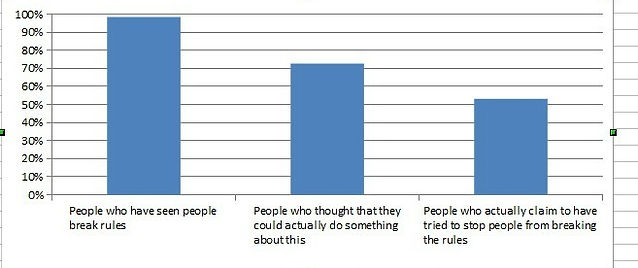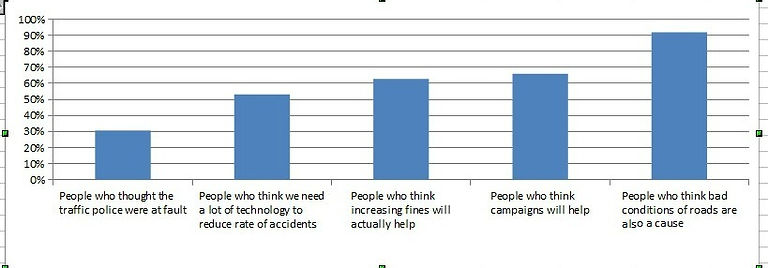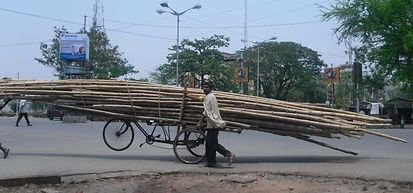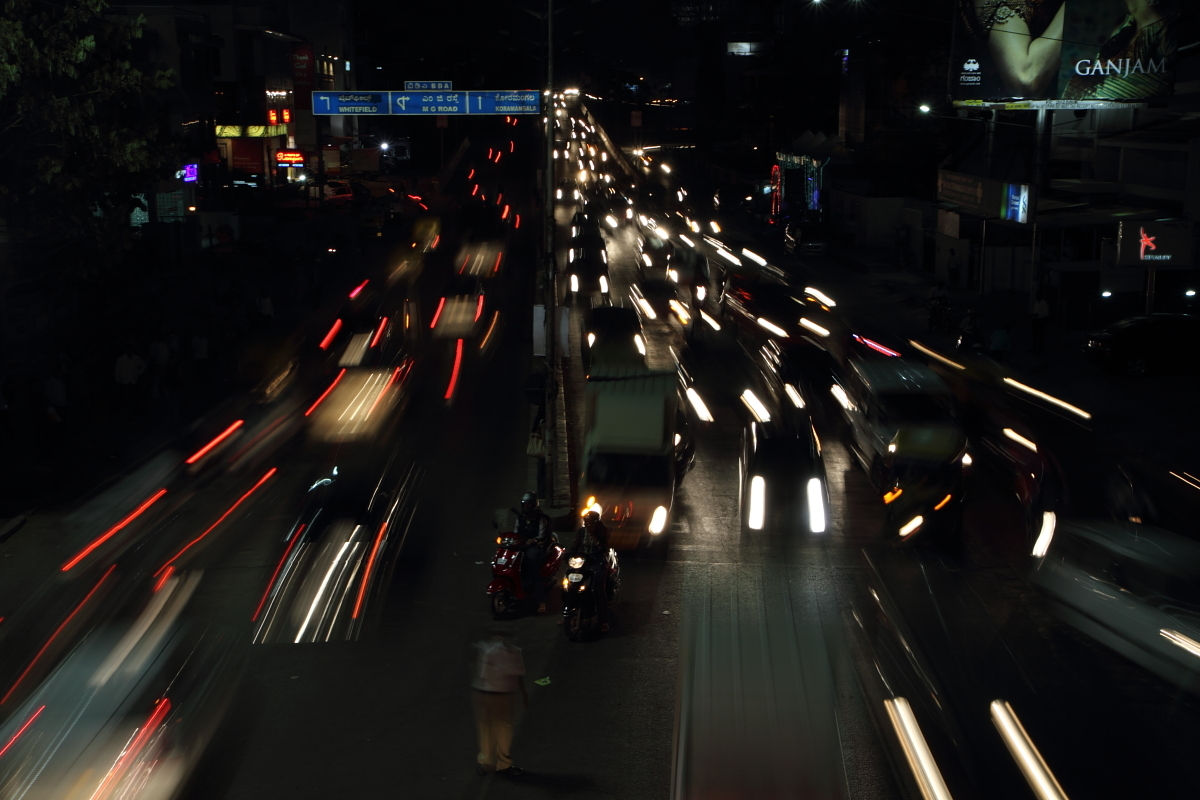
Highway to HELL!
Issues

In our country, India, the population has increased by a massive proportion due to which the percentage of people on the roads (pedestrians, cyclists, motorcyclists, car drivers, heavy vehicle drivers, etc.) has also gone up. Majority of the people don't follow the rules, irrespective of whether they are aware of the rules to be followed or not.
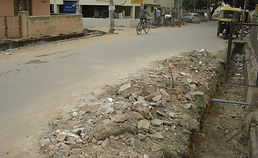


Straight Talk
We interviewed some frequent commuters who grapple with these problems everyday. They share their experiences in this video titled- 'Straight Talk'
To read the transcript of this video, click below.
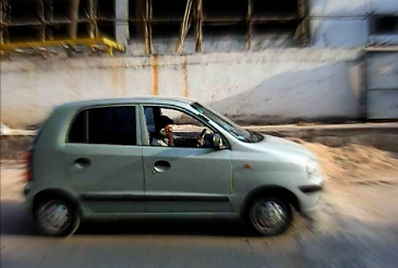
The Problem:
If we compare India with other countries, we find that the estimated road traffic death rates (per 100,000 population) are very high in India. Compared to India, the rates are much lower in Japan and the United Kingdom. Earlier, India was behind China in road accidents and deaths but now India has the dubious distinction of having the higher number of accidents and fatalities on the roads compared to other major countries. According to the World Health Statistics 2008 in ‘Global Status Report on Road Safety: A Time for Action’, road traffic injuries will be the fifth highest leading cause of death in 2030 as compared to it being the ninth highest leading cause of death in 2004.
According to the Report of the Working Group on Road Safety pertaining to Enforcement (2011) Government of India, there were 4,05,637 accidents out of which 71,219 were fatal accidents in the year 2001. In these accidents, 80,888 people got killed and 4,05,215 people were injured. The report also said that these figures have been going up consistently. In India, a city-wise road accident profile for the year 2010, reported in The Hindu (dated 17 April 2012), shows the following:
In 2010, 4,99,628 accidents took place in India out of which 1,19,558 accidents were fatal, 1,34,513 people were killed and 5,27,512 people were injured. The number of fatal accidents in Bangalore where we live is the second highest in India (791), next only to Delhi (2,104). The total number of accidents in Bangalore (6,490) is the third highest in the country, following Delhi (7,260) and Mumbai (28,424). The lowest number of accidents in India was in Varanasi (359) and the lowest number of fatal accidents was in the city of Madurai (120). News reports indicate that a majority of people who cause road accidents are well educated and drive high end cars.
The Working Group on Road Safety Education (2011) of the Ministry of Road Transport and Highways, Government of India in its report quoted the Supreme Court of India “in addition to the devastating human toll, the economic impact of road crashes is enormous. Developing countries face poorly designed and maintained roadways, unsafe vehicles, drivers under the influence of drugs or alcohol, lack of national policies and, above all, lack of effective and meaningful education to the drivers. Success will require significant new resources supported by sustained political commitment”.
Accidents are costly. The total cost includes medical costs, legal costs, and damage to property and motor vehicles. The most important loss is that of loosing human life. According to the report by the Government of India about ‘Road Accidents in India, 2009’ which has quoted the World Report on Road Traffic Injury Prevention of WHO, 2004 (page 5), the cost of global road crashes is estimated at USD 518 billion dollars. With so many poor people in the world, this is an unwanted wastage of money as all of us can be much more careful and prevent road accidents. Many people also spend a lot of money on insurances . The best insurance would be staying careful on roads and following rules in the interest of others as well as yourself.
The number of vehicles on the road is increasing day by day. This increases chaos on the road which is indirectly a cause of road accidents. According to the report by the Government of India about ‘Road Accidents in India, 2009’ (page 25), drivers’ fault is the most important factor causing accidents. Drivers’ fault accounted for 78.5% of the total accidents in 2009. The fault of the cyclists and pedestrians was of ‘marginal consequence’. Speeding accounted for a high share of 57.5% of accidents. Intake of alcohol and drugs by drivers was responsible for 7.1% of total accidents. Overloading and overcrowding of vehicles took 19.7% share of the total road accidents.
Key Findings of Global Status Report on Road Safety – Time for Action
• Data from the survey conducted during 2008 indicate 0.66 million reported deaths due to road accidents while estimation as per the model used by the Global Status Report on Road Safety indicate 1.23 million deaths globally reflecting a difference of over 46%.
• Low-income and middle-income countries indicate very high fatality rates (per 100000 persons) estimated at 21.5 and 19.5 respectively vis-à-vis 10.3 in high income countries. Among low income countries, the African region has been estimated to have the highest fatality rate of 32.3.
• Over 90% of the world’s fatalities on the roads occur in low-income and middle-income counties, which have only 48% of the world’s registered vehicles.
• Almost half of those who die in road traffic crashes are pedestrians, cyclists or users of motorized two-wheelers- collectively known as ‘vulnerable road users’ – and this proportion is higher in the poorer economies of the world.
• Speed is a key risk factor for injury among pedestrians and cyclists, and yet only 29% of countries meet basic criteria for reducing speed in urban areas, while less than 10% of countries rate the enforcement of their speed limits as effective.
• The adoption and enforcement of traffic laws appears inadequate in many counties. The
development of effective enforcement of legislation is critical in reducing drink-driving and
excessive speed, and in increasing the use of helmets, seat-belts and child restraints. This survey showed that fewer than half the countries have laws to address all five of these risk factors, while only 15% have laws that can be considered comprehensive in scope.
• Addressing road safety in a comprehensive manner necessitates the involvement of multiple
sectors, such as heath, transport and police. Only one-third of the countries have a national road safety strategy that is endorsed by the government, that includes specific targets, and that has funding allocated for its implementation.
• Huge gaps remain in the quality and coverage of the data that countries collect and report on road traffic injuries. Underreporting of road traffic fatalities remains a big problem in many countries and the situation is even worse with regard to non-fatal injuries. Just 22% of countries had information on the extent of their road traffic injury problem, the costs incurred by their health sector or their national economies, and the data needed to monitor and evaluate interventions accurately.
(Extracted from the Government of India, Ministry of Road Transport and Highways, Transport Research Wing, New Delhi, “Road Accidents in India 2009”, published in 2011)
Our research:
In our research, we found that road accidents are caused due to the following reasons:
- Drivers are found to break basic traffic rules like entering one-way streets from the wrong side, jumping red lights, suddenly changing lanes, etc.
- Most often, people do not follow the basic safety precautions such as wearing helmets while riding two-wheelers, strapping on their seat belts while in cars and other four-wheelers.
- Often helmets are not worn by people as it is not considered "fashionable" by them. Instead, these helmets are placed on the handlebars or hung on the mirrors. Otherwise, the straps on the helmets are not put on.
- Overloading of vehicles also causes accidents. We saw two wheelers with even four adults, none of them wearing helmets.
- Speeding and Zig- Zag driving on the roads, mostly by youngsters, also poses a risk to the more careful drivers.
- Often, youngsters indulge in bike racing at night. Teenagers and college students must be informed about its various risks.
- Traffic signals that are not working also pose a major risk to the drivers, because the drivers get confused.
- It is often noticed that people who are drunk cause accidents which can be fatal. Also, in our country, India, many homeless people sleep on footpaths and are often run over by vehicles driven by drunken drivers.
- Streetlights are switched off even when required at night. This is not to save electricity but because of negligence.
- The headlights of the cars are often not working and the drivers do not get them replaced. So vehicles driven without lights, especially dark-coloured vehicles, are a risk.
- Even the foglights are kept switched off during foggy days leading to crashes.
- People talk on their cell phones while driving a vehicle. This distracts the drivers.
- Huge hoardings put up on traffic junctions also distract the drivers. Very often, the roads are not lit and the hoardings are brightly lit.
- Bribing of Police Officers lets the offender get away scot-free! Also, the policeman often takes the side of the offender!
- Pedestrians are not considered important and the footpaths and zebra crossings are not provided. This makes the pedestrians walk on the roads instead and coming in the way of drivers.
- The dividers are often made of stones which makes it easy for drivers in a hurry to move the stones and go through the divider. This is a case where the divider is broken and thereby a traffic rule is also broken!
- Poor condition of the roads including large sharp stones, mud, gravel, potholes on the road also leads to accidents.
-Often, policemen do not wear jackets with neon strips. Sometimes, it is also not provided to them.
-Also, signboards and direction boards are often illegible due to their size and cannot be read. Some cannot be read at night as the streets are not properly lit.
-Horns must not be honked unnecessarily as it might rush the driver in front resulting in an accident.
-Beggers and vendors , often on roads especially on busy junctions, might get hit by a vehicle.
-Roads are often not constructed properly. So they wear off fast and begin to crumble. Also, they are not planned well during construction.
- Stray animals such as dogs and cows also come in the way of drivers and make them switch lanes suddenly. Sometimes these animals are also run over.
- Underage drivers driving without proper training and license is also a cause for road accidents.
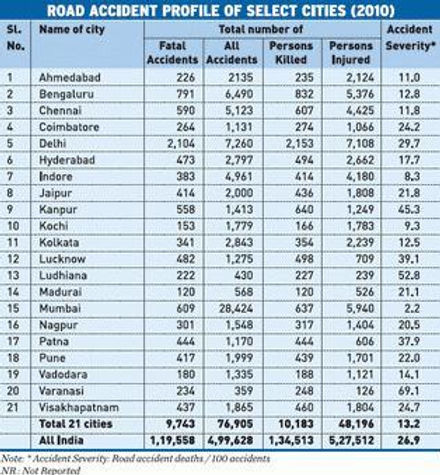
Survey:
We also did a small survey. We interviewed 62 people in our neighbourhood using a questionnaire. This consisted of adults and children, drivers and commuters, men and women. Here is what we found.
Among the people we interviewed, 82 percent have seen at least one road accident.
73% thought they could themselves do something about this.
Almost all (98%) those interviewed had seen people break traffic rules.
53% of the people claimed to have tried stopping people from breaking rules.
92% thought the bad conditions of the road were a cause of road accidents.
31% of the people said that the traffic police were at fault.
53% said that we needed a lot of technology to reduce the rate of accidents.
63% said that increasing fines would help.
66% said that campaigns would help.
Looking at these findings, we thought about implementing some of these solutions. We explored the technology aspects and the penal measures. To know more about this, go to the Solutions page.
We implemented one of the solutions, i.e. awareness campaign to create public knowledge about the basic traffic rules and the implications of breaking traffic rules. To know more about this, see the Documentary and visit the Solutions page.
